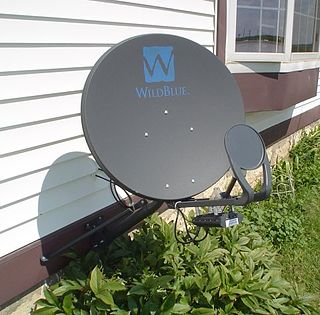
A satellite constellation is a group of artificial satellites working together as a system. Unlike a single satellite, a constellation can provide permanent global or near-global coverage, such that at any time everywhere on Earth at least one satellite is visible. Satellites are typically placed in sets of complementary orbital planes and connect to globally distributed ground stations. They may also use inter-satellite communication.

Satellite Internet access or Satellite Broadband is Internet access provided through communication satellites. Modern consumer grade satellite Internet service is typically provided to individual users through geostationary satellites that can offer relatively high data speeds, with newer satellites using Ku band to achieve downstream data speeds up to 506 Mbit/s. In addition, new satellite internet constellations are being developed in low-earth orbit to enable low-latency internet access from space.

Telesat, formerly Telesat Canada, is a Canadian satellite communications company founded on May 2, 1969. The company is headquartered in Ottawa.

The Anik satellites are a series of geostationary communications satellites launched for Telesat Canada for television, voice and data in Canada and other parts of the world, from 1972 through 2013. Some of the later satellites in the series remain operational in orbit, while others have been retired to a graveyard orbit. The naming of the satellite was determined by a national contest, and was won by Julie-Frances Czapla of Saint-Léonard, Québec. In Inuktitut, Anik means "little brother".

SES S.A. is a Luxembourgish satellite telecommunications network provider supplying video and data connectivity worldwide to broadcasters, content and internet service providers, mobile and fixed network operators, governments and institutions.

The Nimiq satellites are a Canadian fleet of geostationary telecommunications satellites owned by Telesat and used by satellite television providers including Bell Satellite TV and EchoStar. 'Nimiq' is an Inuit word used for an object or a force which binds things together. A contest in 1998 was held to choose the name of these satellites. The contest drew over 36,000 entries. Sheila Rogers, a physiotherapist from Nepean, Ontario, submitted the winning name.
Astra 1E is one of the Astra communications satellites in geostationary orbit owned and operated by SES. It was launched in October 1995 to the Astra 19.2°E orbital slot initially to provide digital television and radio for direct-to-home (DTH) across Europe.

Viasat is an American communications company based in Carlsbad, California, with additional operations across the United States and worldwide. Viasat is a provider of high-speed satellite broadband services and secure networking systems covering military and commercial markets.

Inmarsat is a British satellite telecommunications company, offering global mobile services. It provides telephone and data services to users worldwide, via portable or mobile terminals which communicate with ground stations through fifteen geostationary telecommunications satellites.
Hughes Network Systems, LLC is a wholly owned subsidiary of EchoStar. It is headquartered in Germantown, Maryland and provides satellite internet service. HughesNet has more than 1.4 million subscribers in the Americas.
The A2100 is a model of communications satellite spacecraft made by Lockheed Martin Space Systems. It is used as the foundation for telecommunications payloads in geosynchronous orbit, as well as GOES-R weather satellites and GPS Block IIIA satellites. Over 40 satellites use the A2100 bus.
The DirecTV satellite fleet is a group of communications satellites located at various geostationary orbits that DirecTV uses for their satellite television service and HughesNet internet service. The "DirecTV" prefix in their names has been changed to "T".

O3b is a satellite constellation in Medium Earth orbit (MEO) owned and operated by SES, and designed to provide low-latency broadband connectivity to remote locations for mobile network operators and internet service providers, maritime, aviation, and government and defence. It is often referred to as O3b MEO to distinguish these satellites from SES's forthcoming O3b mPOWER constellation.

Tooway satellite broadband Internet service available across Europe. The first version of the service was launched in 2007 via two Eutelsat geostationary satellites, Hot Bird 6 and Eurobird 3, respectively at the 13° and 33° East orbital positions.

KA-SAT is a high-throughput geostationary telecommunications satellite owned by Viasat. The satellite provides bidirectional broadband Internet access services across Europe and a small area of the Middle East, and additionally the Saorsat TV service to Ireland. It is positioned at 9°E, joining the Eurobird 9A Ku band satellite. KA-SAT was manufactured by EADS Astrium, based on the Eurostar E3000 platform, with a total weight of 6 tons. It was launched by Proton in December 2010. The satellite is named after the Ka band frequency, which is used on the spacecraft.
Nimiq-5 is a Canadian communications satellite, operated by Telesat Canada as part of its Nimiq fleet of satellites. It is positioned in geostationary orbit at a longitude of 72.7° West of the Greenwich Meridian. As of July 2015, EchoStar Corporation leases the satellite's entire capacity to provide high-definition television direct-to-home broadcasting for Dish Network Corporation. When accessed using a multi-satellite receiver such as the VIP722k and a multi-satellite dish/LNB combo, such as the Dish-300, Dish-500, or Dish-Turbo 1000.4, the satellite is referred to by the on-screen diagnostics as Echostar 72 W.
High-throughput satellite (HTS) is a communications satellite that provides more throughput than a classic FSS satellite for the same amount of allocated orbital spectrum, thus significantly reducing cost-per-bit. ViaSat-1 and EchoStar XVII do provide more than 100 Gbit/s of capacity, which is more than 100 times the capacity offered by a conventional FSS satellite. When it was launched in October 2011 ViaSat-1 had more capacity than all other commercial communications satellites over North America combined.

ViaSat-2 is a commercial communications satellite launched June 1, 2017 and went live late February 2018. It was advertised to be the world's highest capacity communications satellite with a throughput of 300 Gbit/s, exceeding that of HughesNet EchoStar XIX, which launched in December 2016. It is the second Ka-band satellite launched by ViaSat after ViaSat-1. The satellite provides internet service through ViaSat to North America, parts of South America, including Mexico and the Caribbean, and to air and maritime routes across the Atlantic Ocean to Europe.

Xplore Inc. is a Woodstock, New Brunswick-based rural internet service provider. It is the largest rural focused broadband service provider in Canada.
ViaSat-3 is a planned global constellation of three geostationary Ka-band communications satellites, the first of which was launched in 2023 by Viasat, Inc. The satellites are intended to provide broadband connectivity with speeds of 100-plus megabits per second to homes, business and enterprise internet users, commercial, government and business aircraft, as well as government and defense markets, maritime and oceanic enterprises in the Americas, Europe, the Middle East, Africa and Asia-Pacific.












